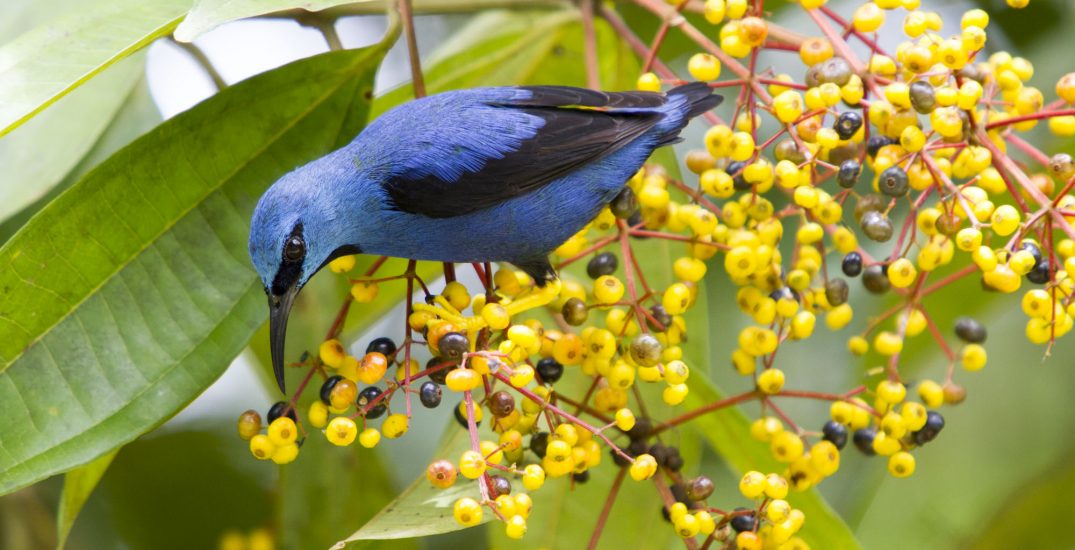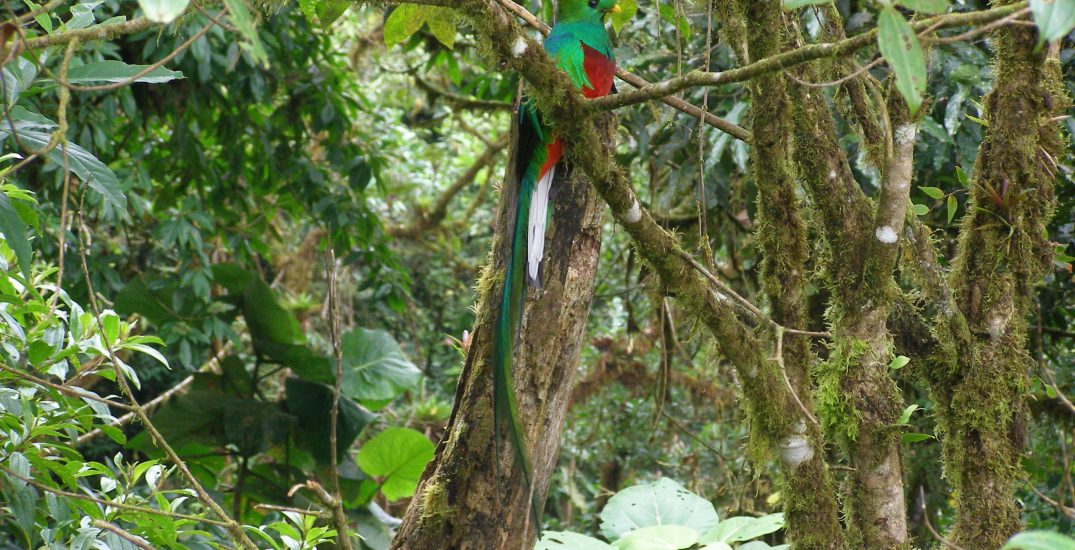Costa Rica can boast more than 850 species of birds (including a high number of regional endemics) in an extremely small area, approximately the same size as Wales. It is one of the most biodiversity places on the planet thanks to its position between North and South America, Costa Rica offers to birders great bird-watching opportunities within relatively short distances, involving very diverse habitats in the six ornithologist regions of the country, from sea level to high mountains above 11.000 f.a.s.l.
Many of Costa Rica’s year round avian inhabitants are colorful, tropical varieties, such as hummingbirds, parrots, toucans and trogons. Others are drab, shy and secretive like the ant-birds and wood-creepers.
From December to April, you can add winter-resident migrants from North America to your list. There is an excellent field guide and a good site guide with sketch maps of birding trails and local species lists.
Program summary:
Day 1: San José
Day 2: Quetzals National Park
Day 3: Quetzals National Park
Day 4: Turrialba Valley
Day 5: Sarapiquí Rainforest
Day 6: Sarapiquí Rainforest
Day 7: Caño Negro Wetlands
Day 8: Caño Negro Wetlands
Day 9: Nicoya Gulf
Day 10: Nicoya Gulf
Day 11: Carara National Park
Day 12: Carara National Park
Day 13: Tfr. to SJO Int’l Airport
Day by Day Itinerary
Day 1: SJO INT’L AIRPORT – SAN JOSE OUTSKIRTS
Arrive at SJO Int’l Airport; meeting and assistance outside the terminal, then transfer to Bougainvillea hotel; located at San Jose outskirts, the perfect place to start a Costa Rica birding tour, surrounded by a large garden full trees, bushes, beautiful flowers, heliconias, gigers, bromelias and even orchids that attracts many butterflies and some of the more common birds of the Central Valley.
Day 2: SAN JOSE OUTSKIRTS – QUETZALS VALLEY
Breakfast, Lunch & Dinner
Birding and early coffee, great combination! Then, depart towards San Gerardo de Dota, a small community in the Talamanca Mountain Range in the midst of a precious ecosystem, the Tropical Cloud forest, filled with massive oaks and other native species. The woods serve as a sanctuary for a large number of mammals and innumerable species of insects, amphibians, and amazing plants and of course, the abundant beautiful birds.
The Savegre Cloud forest is definitely a paradise for birdwatchers, where the Resplendent Quetzal can be seen all year around and hummingbirds fly all over the place, just to mention a few: White-throated Mountain-gem, Volcano Hummingbird, Scintillant Hummingbird, Green-crowned Brilliant, among many others. Collared Trogon, Acorn Woodpecker, Yellow-thighed Finch, Dark Pewee, and Emerald Tucanets, and occasionally, but seen lately, an Ornate Hawk-Eagle, can also be in your list at the end of the day. You will be arriving to this destination before noon, lunch and afternoon birding walk. Night in a San Gerardo de Dota (Savegre) area.
Day 3: QUETZALS VALLEY
Breakfast & Dinner
You will have the entire day to bird at the Quetzals National Park with your guide at this excellent location. Right after breakfast, you will concentrate on finding the Resplendent Quetzal, and then continue to explore the different areas in Savegre. Rufous-browed Peppershrike, Yellow-bellied Siskin, Yellowish Flycatcher, Flame-throated Warbler, Barred Becard, Silvery-fronted Tapaculo, Zeledonia, Torrent Tyrannulet, are other candidates to be found.
Day 4 // QUETZALS VALLEY – TURRIALBA VALLEY
Breakfast, Lunch & Dinner
We will leave the cool highland climate of San Gerardo de Dota area and drive into the lush green valleys of the Orosi area until reaching the famous Turrialba on the edges of a lush pre-mountain rain forest in the Caribbean zone at 3000 feet.
This afternoon enjoys the numerous species that come near the balcony of the main lodge: Snowcap, White-necked Jacobin, Green Thorntail, Garden Emerald, White-lined Tanager, Brown Jay, and White-throated Crake, just to mention a few.
Day 5 // TURRIALBA VALLEY – SARAPIQUI RAINFOREST
Breakfast & Dinner
Today descend to the warm and humid northern Caribbean lowland rivers of Costa Rica, where we will spend two nights La Selva Lodge located in the Puerto Viejo de Sarapiquí area.
The Sarapiqui area is full of splendid opportunities to hike through lush, mountainous primary rainforest. National Parks and Private preserves throughout Sarapiqui maintain the old growth forests with well-kept trails where the wild life freely roams. It serves as a biological corridor to the Braulio Carrillo National Park and because of its rich biodiversity, is recognized as a scientific research site and the last stronghold of endangered species such as the great green macaw.
Day 6: SARAPIQUI RAINFOREST
Breakfast, Lunch & Dinner
An entire day to explore La Selva Biological Station in search of the regionally endemic Rufous-winged Woodpecker, Snowy Cotinga, Stripe-breasted Wren, and Nicaraguan Seed-Finch, along with other tropical denizens including various toucans, trogons, and tanagers. We will visit part of the 60 kilometers of excellent trails which provide unparalleled access to tropical rain forest habitat that is home to such species as, White-tipped Sicklebill, Green Thorntail, Spectacled Antpitta, Bare-necked Umbrellabird, Canebrake Wren, Black Hawk-Eagle, Slate-coloured Grosbeak, Olive-backed Euphonia, Tiny Hawk, Great and Slaty-breasted Tinamous, Great Curassow, Great Potoo and Great Antshrike — what can we say, it’s “great” birding!
Day 7: SARAPIQUI RAINFOREST – CAÑO NEGRO WETLANDS
Breakfast & Dinner
Today, travel to Cano Negro Wild Life Refuge wetlands located in the remote Northern part of Costa Rica, near the Nicaraguan border in a marshy, jungle-like area.
The refuge is mainly conformed by the not too deep Caño Negro Lagoon and the Rio Frio, both together plays a big role in the birds migration route because is an important source of food to wide range of birds.
Caño Negro is an intense place; it has an extension of 9960 Hs of wetlands that creates the perfect conditions for an extraordinary biodiversity, it is one of the most important biological areas of the country and the four most important wetlands area in the world, it is also a Ramsar Site.
Ask the guide for the possibility to visit on route the Arenal Volcano Area or Celeste River and discover the natural wonders of these majestic attractions.
Day 8: CAÑO NEGRO WETLANDS
Breakfast, Lunch & Dinner
For today, you will visit on a very safe and comfortable boat, the most important points for observation. This ecological treasure is the natural habitat of more than 350 species of birds, among which we find the Nicaraguan Grackle (Quiscalus Nicaraguensis), Nicaraguan endemic whose only bird population in Costa Rican is here in the Caño Negro, Northern Jacana, Neotropical Cormorant (the largest colony in the country), the Great Blue Heron and Anhinga, Roseate Spoonbill, White Ibis, Green Ibis, Glossy Ibis, Wood Storks, the Black-bellied Whistling Duck, the Jabiru Venture (endangered) and others.
Day 9: CAÑO NEGRO WETLANDS – NICOYA GULF, LA ENSENADA
Breakfast & Dinner
After some days at the Caribbean site area, today the drive will take you to the Pacific Coast, specifically to La Ensenada, a private refuge located on Nicoya Gulf in which thousands of birds inhabit during the migration from the north, also a fabulous place to find a seasonal flooded flatland with several habitats like mudflats, lagoons, salt ponds, swamps and extensive coastal areas with rocky beaches and mangroves.
Also a place to find some of the last remnants of the endangered life zone know as tropical lowland dry forest with semi-deciduous forest, evergreen riparian forest, small shrubs, bushes and tropical savanna.
Day 10: NICOYA GULF, LA ENSENADA
Breakfast & Dinner
Full day birding at La Ensenada. The variety of aquatic habitats and landscapes are accessible to hotel guests by an extensive and well-maintained trails system, these habitats attracts some of the most colorfully birds of Costa Rica like Banded Wren, Black-bellied Plovers, Black-necked Stilt, Black-bellied Whistling Ducks, Blue-winged Teals, Crested Caracara, Cinnamon Hummingbird, Canivet’s Emerald, Common Ground-dove, Double-striped Thick-Knee, Eastern Meadowlark, Green-breasted Mango, Great Egret, Hoffman’s Woodpecker, Montezuma Oropendola, Inca Dove, Jabiru, Long tailed Manakin, Lesser Ground-Cuckoo, Limpkin, Little Blue Herons, Melodious Blackbird, Neotropic Cormorant, Northern Jacana’s, Orange-fronted Parakeet, Parrots, parakeets, Pelicans, Rufous-naped Wren, Roseatte Spoonbills, Scrub Euphonia, Stripe-headed Sparrow, Spotted-breasted Oriole, Semipalmated, Stilt Sandpiper, Spot-bellied Bobwhite, Semipalmated Plover, Short-billed Dowitchers, Turqoise-browed Motmot, Thicket Tinamou, Tricolored Herons, Yellow-headed Caracara, Yellow-naped Parrot, White-throated Magpie-jay, White-fronted Parrot, White-tipped Dove, White-lored Gnatcatcher, Whimbrel, Wilson’s Plover, Wood Stork and White Ibis.
Day 11: NICOYA GULF COAST, LA ENSENADA – CARARA N. P.
Breakfast & Dinner
Descending from the hot tropical dry forest and head down the coast and slightly inland to the transition rain and dry tropical forests of Carara National Park with lodging at the lovely Macaw hotel.
Day 12: CARARA N.P. CENTRAL PACIFIC
Breakfast & Dinner
Spend the morning exploring the trails of the Carara National Park, a boundary between tropical dry and humid forest. Though most of the vegetation in the reserve remains evergreen and is characteristic of the wet forest life zone, there are a number of species that lose their leaves during the dry season, showing their affinity to the drier climate found north of the reserve.
However, Carara’s main attraction for most visitors is its wildlife, and star billing goes to the Scarlet Macaw. These large, raucous members of the parrot family add a bright splash of primary colors to the overall green of the rain forest, although at times it is amazing how difficult they can be to see in a leafy tree. It is estimated that about 150 of these blatant birds feed and nest in the reserve. When not brooding eggs or young, they roost in mangroves several kilometers away.
The reserve’s notable birds also include Hoffmann’s Woodpecker, Orange-collared Manakin, Panama Flycatcher and Black-hooded Antshrike. Look for Zone-tailed Hawk, Gray-chested Dove, Long-billed Hermit, Purple-crowned Fairy, Blue-throated Goldentail, Baird’s Trogon, Long-tailed and Tawny-winged Woodcreeper, Dusky and Chestnut-backed Antbird, Dot-winged Antwren, Spectacled Antpitta, Black-faced Antthrush, Golden-crowned Spadebill, Greenish Elaenia, Slate-headed Tody-flycatcher, Northern Bentbill, Rose-throated Becard, Rufous-breasted, Black-bellied and Riverside Wrens, and Western Tanager.
Day 13: CARARA N.P. CENTRAL PACIFIC – SJO INT’L AIRPORT
Breakfast
Thanks to its excellent location, Macaw hotel is located at just 1.5 hours away from Juan Santamaría International Airport (SJO), allowing you to continue enjoying the natural environment and according with your flight itinerary, we will provide departure transfer.
END OF SERVICES
Standard Category
| Location | Name of the Hotel | Category | Type of room | CST |
|---|---|---|---|---|
| Santo Domingo | Bougainvillea | 3 stars + | Standard | 4 |
| Quetzals Valley | Savegre | 3 stars + | Jr. Suite | 4 |
| Turrialba Valley | Rancho Naturalista | Lodge | Standard | N/A |
| Sarapiquí Rainforest | Selva Verde Lodge | Lodge | Standard | 4 |
| Caño Negro Wetlands | Natural Lodge | 3 stars | Standard | 3 |
| Nicoya Gulf | La Ensenada Lodge | Lodge | Standard | 2 |
| Carara N. P. | Macaw Lodge | 3 stars | Standard | 1 |



